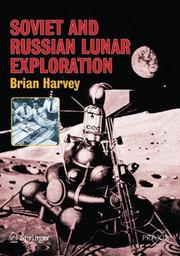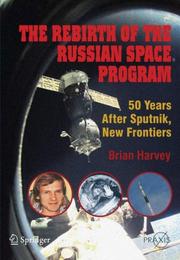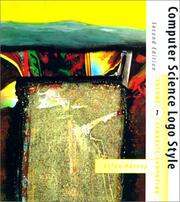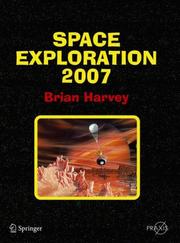| Listing 1 - 10 of 76 | << page >> |
Sort by
|
Book
ISBN: 0132982420 Year: 1994 Publisher: New York (N.Y.): Prentice Hall
Abstract | Keywords | Export | Availability | Bookmark
 Loading...
Loading...Choose an application
- Reference Manager
- EndNote
- RefWorks (Direct export to RefWorks)
bedrijfsethiek --- Professional ethics. Deontology --- Organization theory --- Business ethics --- Morale des affaires --- Case studies --- Cas, Etudes de --- 241.67 --- 174.5 --- -#GBIB:Overlegcentrum Christelijke Ethiek --- Business --- Businesspeople --- Commercial ethics --- Corporate ethics --- Corporation ethics --- Professional ethics --- Wealth --- Business ethics. Corporate ethics. Bedrijfscodes. Management en ethiek. Zakenmoraal --- Economische ethiek. Speculatie --- Moral and ethical aspects --- 174.5 Economische ethiek. Speculatie --- 241.67 Business ethics. Corporate ethics. Bedrijfscodes. Management en ethiek. Zakenmoraal --- -Case studies

ISBN: 1281043060 9786611043063 0387739769 0387218963 Year: 2007 Publisher: New York, NY : Springer New York : Imprint: Praxis,
Abstract | Keywords | Export | Availability | Bookmark
 Loading...
Loading...Choose an application
- Reference Manager
- EndNote
- RefWorks (Direct export to RefWorks)
Little is known of Soviet and Russian lunar exploration although, in fact, the Soviet Union/Russia: Sent the first spaceships past the moon, the first to hit the moon and the first to circle the moon Was first to soft land on and orbit the moon Was first to send a spaceship around the moon and recover it on Earth Came very close to sending a cosmonaut around the moon first Built and successfully tested, in Earth orbit, a lunar lander Pioneered sophisticated, precise high-speed reentries into the Earth's atmosphere Came close to perfecting a giant moon rocket, the N-1 Retrieved three sets of rock samples from the moon by automatic spacecraft Landed advanced roving laboratories that explored the moon for months on end, traveling 48km Designed long-term lunar bases. These were remarkable achievements requiring a considerable level of engineering sophistication and have a place in the contemporary story of astronautics. Recent landings on Mars use, essentially, the very techniques developed by Russia to land on and explore the moon in the 1960s and 1970s. As an acknowledged expert and author of several books on the Soviet and Russian space programme, Brian Harvey is ideally suited to cover not only the engineering and scientific side but also the human stories of the Soviet and Russian lunar programme. These include those of the cosmonaut squad that trained to land on the moon, but was stood down, and of the designers who tried to realise the dream of a Russian moon, from Tikhonravov to Mishin: a Soviet lunar programme was first proposed by designer Mikhail Tikhonravov in a children’s magazine in 1951 and he persuaded a sceptical Soviet leadership of the value of a moon programme. Following Sputnik, the first lunar flights quickly achieved the key goals of hitting, circling and photographing the moon in 1959. The Soviet Union achieved all the early ‘firsts’ in lunar exploration, such as soft landing and orbiting the moon, and Brian Harvey will recount the frantic efforts to rival America’s Apollo and the dramatic hours of 21st July 1969, when Russia tried to soft land Luna 15 in the Sea of Crises even as Armstrong and Aldrin explored the moon in the nearby Sea of Tranquility.
Astronautics. --- Space sciences --- Aeronautics --- Astrodynamics --- Space flight --- Space vehicles --- Moon --- Exploration. --- Astronomy. --- Popular Science in Astronomy. --- Aerospace Technology and Astronautics. --- Astronomy, Observations and Techniques. --- Aerospace engineering. --- Observations, Astronomical. --- Astronomy—Observations. --- Astronomical observations --- Observations, Astronomical --- Aeronautical engineering --- Astronautics --- Engineering --- Exploration --- History. --- Earth (Planet) --- Satellite
Book
ISBN: 1280945095 9786610945092 0387496645 Year: 2007 Publisher: New York, NY : Springer New York : Imprint: Springer,
Abstract | Keywords | Export | Availability | Bookmark
 Loading...
Loading...Choose an application
- Reference Manager
- EndNote
- RefWorks (Direct export to RefWorks)
Russia’s accomplishments in planetary space exploration were not achieved easily. Formerly, the USSR experienced frustration in trying to tame unreliable Molniya and Proton upper stages and in tracking spacecraft over long distances. This book will assess the scientific haul of data from the Venus and Mars missions and look at the engineering approaches. The USSR developed several generations of planetary probes: from MV and Zond to the Phobos type. The engineering techniques used and the science packages are examined, as well as the nature of the difficulties encountered which ruined several missions. The programme’s scientific and engineering legacy is also addressed, as well as its role within the Soviet space programme as a whole. Brian Harvey concludes by looking forward to future Russian planetary exploration (e.g Phobos Grunt sample return mission). Several plans have been considered and may, with a restoration of funding, come to fruition. Soviet studies of deep space and Mars missions (e.g. TMK, Aelita) have much to offer contemporary planners in Europe and the United States. Long-duration ISS and Mir missions provide a medical record of considerable value in constructing human exploration of Mars. Illustrated with the photographs taken by Soviet Venus and Mars probes, pictures of the spacecraft, diagrams of the flight paths and landing techniques and maps of the landing sites, the book will build on the published scientific papers from the programme, archived material and memoirs and other material coming to light in recent years.
Astronautics --- Space flight to Mars. --- Space flight to Venus. --- Planets --- Interplanetary voyages. --- Space flights. --- Exploration. --- Interplanetary voyages --- Space sciences --- Aeronautics --- Astrodynamics --- Space flight --- Space vehicles --- Manned space flights --- Missions (Astronautics) --- Voyages and travels --- Space travel --- Voyages, Interplanetary --- Rockets (Aeronautics) --- Astrophysics. --- Astronomy, Observations and Techniques. --- Space Sciences (including Extraterrestrial Physics, Space Exploration and Astronautics). --- Astronomical physics --- Astronomy --- Cosmic physics --- Physics --- Observations, Astronomical. --- Astronomy—Observations. --- Space sciences. --- Science and space --- Space research --- Cosmology --- Science --- Astronomical observations --- Observations, Astronomical

ISBN: 1281134031 9786611134037 0387713565 0387713549 Year: 2007 Publisher: New York, NY : Springer New York : Imprint: Springer,
Abstract | Keywords | Export | Availability | Bookmark
 Loading...
Loading...Choose an application
- Reference Manager
- EndNote
- RefWorks (Direct export to RefWorks)
The rebirth of the Russian space program marks an important event: 50 years since the first Sputnik was launched on 4th October 1957. At that time, few could have imagined the dramatic events that lay head. The Soviet Union achieved all the great firsts in cosmonautics—the first satellite in orbit, the first animal in orbit, the first laboratory in orbit, the first probe to the Moon, the first probe to photograph its far side, the first soft landing on the moon, the first man in space, the first woman in space, the first spacewalk. Except one, the first human landing on the Moon. In 1964, the Soviet Union decided to contest the decision of the United States to put the first person on the Moon. The Soviet Union engaged in that race far too late, with divided organization, and made a gallant but doomed challenge to Apollo. Undaunted, the Soviet Union rebuilt its space program around orbiting stations, building the first one, Salyut, and then the first permanent home in space, Mir. The Soviet Union still achieved many more firsts: the first lunar rover, the first soft landing on Venus, the first soft landing on Mars, the first recovery of samples from the Moon by automatic spacecraft.
Astronautics --- History. --- Popular works. --- Observations, Astronomical. --- Astronomy --- Space sciences. --- Astronomy. --- Automotive engineering. --- Popular Science. --- Popular Science in Astronomy. --- Automotive Engineering. --- Astronomy, Observations and Techniques. --- Extraterrestrial Physics, Space Sciences. --- Physical sciences --- Space sciences --- Science and space --- Space research --- Cosmology --- Science --- Astronomical observations --- Observations, Astronomical --- Observations. --- Engineering. --- Astrophysics. --- Space Sciences (including Extraterrestrial Physics, Space Exploration and Astronautics). --- Astronomical physics --- Cosmic physics --- Physics --- Construction --- Industrial arts --- Technology --- Astronomy—Observations.
Book
ISBN: 0262580802 0262580721 9780262580724 9780262580809 Year: 1985 Publisher: Cambridge (Mass.): MIT press
Abstract | Keywords | Export | Availability | Bookmark
 Loading...
Loading...Choose an application
- Reference Manager
- EndNote
- RefWorks (Direct export to RefWorks)
681.3*D32 --- 681.3*K3 --- language classifications: applicative languages data-flow languages design languages extensible languages macro and assembly languages nonprocedural languages specialized application and very high-level languages (Programminglanguages) --- Computers and education --- 681.3*K3 Computers and education --- 681.3*D32 language classifications: applicative languages data-flow languages design languages extensible languages macro and assembly languages nonprocedural languages specialized application and very high-level languages (Programminglanguages) --- LOGO (Computer program language). --- LOGO (Langage de programmation) --- LOGO (Computer program language) --- language classifications: applicative languages; data-flow languages; design languages; extensible languages; macro and assembly languages; nonprocedural languages; specialized application and very high-level languages (Programminglanguages) --- 681.3*D32 language classifications: applicative languages; data-flow languages; design languages; extensible languages; macro and assembly languages; nonprocedural languages; specialized application and very high-level languages (Programminglanguages) --- Computer programming --- 681.3*A1 --- 681.3*A1 Introductory and survey --- Introductory and survey --- Computers --- Electronic computer programming --- Electronic data processing --- Electronic digital computers --- Programming (Electronic computers) --- Coding theory --- Programming languages (Electronic computers) --- Programming --- Computer programming. --- Programmation des ordinateurs
Book
ISBN: 146145042X 1461450438 9781461450429 Year: 2013 Publisher: New York, NY : Springer New York : Imprint: Springer,
Abstract | Keywords | Export | Availability | Bookmark
 Loading...
Loading...Choose an application
- Reference Manager
- EndNote
- RefWorks (Direct export to RefWorks)
The 21st century has seen the emergence, after the Soviet Union and the United States, of the third great space superpower: China. Here, in China in Space - The Great Leap Forward, Brian Harvey takes a contemporary look at the new Chinese space program. China has already launched its first space station, Tiangong; has sent its first spacecraft to the Moon, the Chang e; and has plans to send spaceships to Mars and further afield. China's annual launch rate has already overtaken those of both Europe and the United States. Huge new production plants and launch centers are under construction, to build and launch the new family of Long March 5, 6, and 7 rockets. In Roadmap 2050, the Academy of Sciences indicates that China intends to be the leading spacefaring nation by mid-century, with bases on the Moon and Mars. This book gives an informed, fully up-to-date commentary on all aspects of the Chinese space program, including its history, development, technology, missions, and the personalities involved. It lists all the Chinese launches, missions, and terminology, going behind the press releases to draw on hitherto unused scientific papers and sources. China in Space is a unique, forward-looking account of the Chinese space program, covering its full range of missions: manned, communications, scientific, military, technology-testing, and lunar.
Astronautics -- China. --- Outer space. --- Space ships. --- Astronautics --- Mechanical Engineering --- Engineering & Applied Sciences --- Aeronautics Engineering & Astronautics --- Space race --- Engineering. --- Space sciences. --- Astronomy. --- Aerospace engineering. --- Astronautics. --- Aerospace Technology and Astronautics. --- Popular Science in Astronomy. --- Extraterrestrial Physics, Space Sciences. --- Space sciences --- Aeronautics --- Astrodynamics --- Space flight --- Space vehicles --- Astrophysics. --- Space Sciences (including Extraterrestrial Physics, Space Exploration and Astronautics). --- Astronomical physics --- Astronomy --- Cosmic physics --- Physics --- Science and space --- Space research --- Cosmology --- Science --- Aeronautical engineering --- Engineering --- China. --- China --- Rotchina --- Zhongguo --- Zhongguo-Diguo --- Kaiserreich Zhongguo --- Chung-kuo --- Zhonghua-minguo --- Chung-hua-min-kuo --- Zhonghua-Renmin-Gongheguo --- Kaiserreich China --- PRC --- Shinkoku --- Chung-hua-jen-min-kung-ho-kuo --- Zhonghua --- Volksrepublik China --- VR China --- People's Republic of China --- Zhong guo --- Zhonghua renmin gongheguo --- République populaire de Chine --- Chung-kuo kuo min cheng fu --- Chine --- KNR --- Chinese People's Republic --- Kytajsʹkaja Narodnaja Respublika --- Chinese People’s Republic --- Republic of China --- Chung-hua min kuo --- 中华人民共和国 --- Chinesen --- Taiwan --- 1949 --- -BNKhAU --- Bu̇gd Naĭramdakh Dundad Ard Uls --- Bu̇gu̇de Nayiramdaqu Dumdadu Arad Ulus --- Bu̇gu̇de Nayiramdaxu Dundadu Arad Ulus --- Catay --- Cathay --- Central Government of the People's Republic of China --- Central People's Government of Communist China --- Chinese National Government --- Chūka Jinmin Kyōwakoku --- Chung-hua chung yang jen min kung ho kuo --- Chung-hua jen min kung ho kuo --- Chung yang jen min cheng fu --- Cina --- Činská lidová republika --- Dumdad Uls --- Dumdadu Ulus --- Erets Sin --- Jhonggu --- Jumhūriyat al-Ṣīn al-Shaʻbīyah --- Khi͡atad --- Kínai Népköztársaság --- Kin --- Kitad --- Kita --- Kitaĭskai͡a Narodnai͡a Respublika --- Kitajska --- Kytaĭsʹka Narodna Respublika --- National Government --- P.R.C. --- P.R. China --- PR China --- Republic --- República Popular China --- Republik Rakjat Tiongkok --- République Populaire de Chine --- RRC --- RRT --- Sāthāranarat Prachāchon Čhīn --- VRChina --- Zhong hua ren min gong he guo --- Zhonghua Renmin Gongheguo --- Zhonghuaminguo --- S19/0200 --- S10/0840 --- S10/0835 --- S07/0350 --- China: Natural sciences--Astronomy, chronometry, zodiac etc --- China: Economics, industry and commerce--Aviation --- China: Economics, industry and commerce--Postal service and telecommunications: since 1949 (including E-commerce) --- China: Army and police force--Army, navy and air force: since 1949

ISBN: 0262581485 0262581515 0262581493 0262581507 0262286815 058505326X 0262286823 0585053464 0262286831 0585032459 9780262286817 9780262286824 9780262286831 9780262581516 9780262581486 9780262581493 9780262581509 0026581507 9780026581509 9780585053264 9780585053462 9780585032450 Year: 1997 Publisher: Cambridge, Massachusetts : MIT Press,
Abstract | Keywords | Export | Availability | Bookmark
 Loading...
Loading...Choose an application
- Reference Manager
- EndNote
- RefWorks (Direct export to RefWorks)
Computer Science --- Engineering & Applied Sciences --- Computer programming. --- LOGO (Computer program language) --- LOGO (Computer program language). --- Computers --- Electronic computer programming --- Electronic data processing --- Electronic digital computers --- Programming (Electronic computers) --- Coding theory --- Programming languages (Electronic computers) --- Programming
Book
ISBN: 3319681400 3319681389 9783319681405 Year: 2018 Publisher: Cham : Springer International Publishing : Imprint: Springer,
Abstract | Keywords | Export | Availability | Bookmark
 Loading...
Loading...Choose an application
- Reference Manager
- EndNote
- RefWorks (Direct export to RefWorks)
Explorer was the original American space program and Explorer 1 its first satellite, launched in 1958. Sixty years later, it is the longest continuously running space program in the world, demonstrating to the world how we can explore the cosmos with small spacecraft. Almost a hundred Explorers have already been launched. Explorers have made some of the fundamental discoveries of the Space Age.Explorer 1 discovered Earth’s radiation belts. Later Explorers surveyed the Sun, the X-ray and ultraviolet universes, black holes, magnetars and gamma ray bursts. An Explorer found the remnant of the Big Bang. One Explorer chased and was the first to intercept a comet. The program went through a period of few launches during the crisis of funding for space science in the 1980s. However, with the era of ‘faster, cheaper, better,’ the program was reinvented, and new exiting missions began to take shape, like Swift and the asteroid hunter WISE. Discovering the Cosmos with Small Spacecraft gives an account of each mission and its discoveries. It breaks down the program into its main periods of activity and examines the politics and debate on the role of small spacecraft in space science. It introduces the launchers (Juno, Thor, etc.), the launch centers, the ground centers and key personalities like James Van Allen who helped develop and run the spacecraft’s exciting programs.
Physics. --- Planetology. --- Astrobiology. --- Astronomy. --- Aerospace engineering. --- Astronautics. --- Space Sciences (including Extraterrestrial Physics, Space Exploration and Astronautics). --- Popular Science in Astronomy. --- Aerospace Technology and Astronautics. --- Outer space --- Exploration. --- Solar system --- Exploration --- Astrophysics. --- Astrobiology --- Biology --- Habitable planets --- Life --- Planetary sciences --- Planetology --- Space sciences --- Aeronautics --- Astrodynamics --- Space flight --- Space vehicles --- Astronomical physics --- Astronomy --- Cosmic physics --- Physics --- Origin --- Astronautics --- Space sciences. --- Aeronautical engineering --- Engineering --- Science and space --- Space research --- Cosmology --- Science

ISBN: 1281043281 9786611043285 0387487581 0387333304 Year: 2007 Publisher: New York, NY : Springer New York : Imprint: Springer,
Abstract | Keywords | Export | Availability | Bookmark
 Loading...
Loading...Choose an application
- Reference Manager
- EndNote
- RefWorks (Direct export to RefWorks)
The aim of the Space Exploration - 2007 is to provide an annual update on recent space launches, missions and results, to be published every year in September. The annual will cover space exploration from a variety of angles: looking back at past missions, reviewing those currently under way and looking to those planned for the future. The ten invited contributions each year will cover a variety of topics within these areas, to appeal to a wide readership. The regular set features, which will appear every year, will include records noting satellite and rocket launches in the previous year and satellite recoveries; analysis of developments and emerging trends in space exploration; notes on records and main feats during the year; basic data on all launchers currently in operation; schedules of upcoming missions; anniversaries and landmarks.
Astronautics. --- Outer space --- Exploration. --- Popular works. --- Observations, Astronomical. --- Astronomy --- Space sciences. --- Astronomy. --- Automotive engineering. --- Aerospace engineering. --- Popular Science. --- Popular Science in Astronomy. --- Aerospace Technology and Astronautics. --- Extraterrestrial Physics, Space Sciences. --- Automotive Engineering. --- Astronomy, Observations and Techniques. --- Space sciences --- Aeronautics --- Astrodynamics --- Space flight --- Space vehicles --- Aeronautical engineering --- Astronautics --- Engineering --- Physical sciences --- Science and space --- Space research --- Cosmology --- Science --- Astronomical observations --- Observations, Astronomical --- Observations. --- Solar system --- Exploration --- Astrophysics. --- Engineering. --- Space Sciences (including Extraterrestrial Physics, Space Exploration and Astronautics). --- Construction --- Industrial arts --- Technology --- Astronomical physics --- Cosmic physics --- Physics --- Astronomy—Observations.
Book
ISBN: 3030195880 3030195872 9783030195885 Year: 2019 Publisher: Cham : Springer International Publishing : Imprint: Springer,
Abstract | Keywords | Export | Availability | Bookmark
 Loading...
Loading...Choose an application
- Reference Manager
- EndNote
- RefWorks (Direct export to RefWorks)
In 2019, China astonished the world by landing a spacecraft and rover on the far side of the Moon, something never achieved by any country before. China had already become the world’s leading spacefaring nation by rockets launched, sending more into orbit than any other. China is now a great space superpower alongside the United States and Russia, sending men and women into orbit, building a space laboratory (Tiangong) and sending probes to the Moon and asteroids. Roadmap 2050 promises that China will set up bases on the Moon and Mars and lead the world in science and technology by mid-century. China’s space programme is one of the least well-known, but this book will bring the reader up to date with its mysteries, achievements and exciting plans. China has built a fleet of new, powerful Long March rockets, four launch bases, tracking stations at home and abroad, with gleaming new design and production facilities. China is poised to build a large, permanent space station, bring back lunar rocks, assemble constellations of communications satellites and send spaceships to Mars, the moons of Jupiter and beyond. A self-sustaining lunar base, Yuegong, has already been simulated. In space, China is the country to watch.
Astronautics. --- Astrophysics. --- China-History. --- Popular Science in Technology. --- Aerospace Technology and Astronautics. --- Space Sciences (including Extraterrestrial Physics, Space Exploration and Astronautics). --- History of China. --- Astronomical physics --- Astronomy --- Cosmic physics --- Physics --- Space sciences --- Aeronautics --- Astrodynamics --- Space flight --- Space vehicles --- Technology. --- Aerospace engineering. --- Space sciences. --- China—History. --- Science and space --- Space research --- Cosmology --- Science --- Aeronautical engineering --- Astronautics --- Engineering --- Applied science --- Arts, Useful --- Science, Applied --- Useful arts --- Industrial arts --- Material culture
| Listing 1 - 10 of 76 | << page >> |
Sort by
|

 Search
Search Feedback
Feedback About
About Help
Help News
News